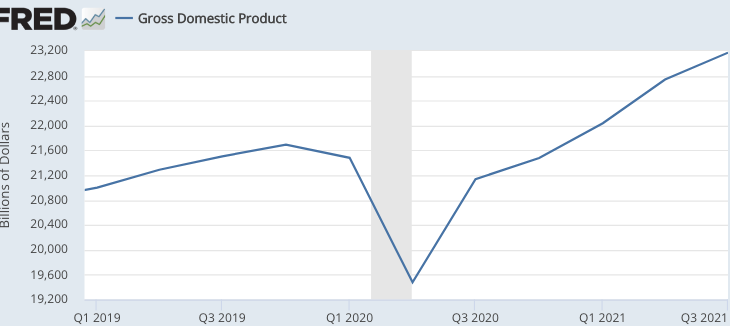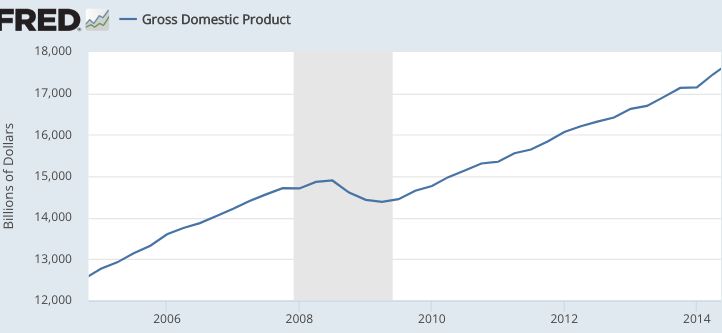The 3rd quarter NGDP figures were just released, and they show the nominal economy is roughly back on the old trend line, with NGDP rising at a 3.8% annual rate since the fourth quarter of 2019.

The economy still has lots of problems, but they are no longer nominal problems, they are real problems. Or, if you prefer the confusing terminology used by economists, the economy no longer has a “demand” problem; it has “supply” problems.
What a contrast to the Great Recession, which we entered with a trend rate of NGDP growth of roughly 5%, then quickly fell 8% below trend, and then instead of returning to the old trend line we started recovering along an even lower trend line of roughly 4% NGDP growth. Unemployment fell very slowly.

This time, the Fed used its new flexible average inflation targeting (FAIT) approach to aggressively push the economy back to the old trend line. And it worked perfectly! Unemployment fell from 14.8% to 4.8% in only 17 months, something almost no one (other than Lars Christensen) anticipated last year.
My only fear is that we might overshoot. NGDP growth was at an annual rate of 7.8% in the third quarter, which is fine when recovering from a recession. But we wouldn’t want growth to continue at that clip going forward. The Fed needs to bring NGDP growth down to a level of roughly 4%, to insure it can meet its FAIT objectives for the 2020s. The TIPS spreads have me a bit worried.
PS. Would slowing to 4% NGDP growth cause a rise in unemployment? I don’t think so. There’s a massive labor shortage out there, and the areas of the economy that are currently overheating are concentrated in consumer goods, which are often imported. There needs to be some rebalancing toward (job intensive) services, but that can occur with 4% NGDP growth. To be clear, I think NGDP growth will probably overshoot 4% next this quarter, but the Fed needs to bring it back to roughly that level ASAP. And yes, the actual target is 2% inflation, not 4% NGDP growth. But they won’t achieve that over the 2020s unless NGDP growth is relatively close to 4%. Please don’t turn success into failure!
PPS. Notice that when NGDP recovers quickly we don’t have a financial crisis? That’s not a coincidence. Financial crises occur with deep and prolonged declines in NGDP.
PPPS. The Hypermind NGDP market is now predicting negative NGDP growth in Q4. If you disagree, then I’d encourage you to place your bets.


READER COMMENTS
John Hall
Oct 28 2021 at 12:47pm
I’m not seeing a negative forecast for NGDP in Q4 in that link that you sent. I see 7.35% YoY. It would be nice if that site had a way to download the history of all the forecasts. At a daily basis it would be nice, but I imagine it would make for a good project to see how quickly the forecasts change to Fed announcements and such.
With respect to your point on “supply” problems, I just finished your new book and I recall that it refers to your statistical work on shocks that are in the same direction for GDP and inflation as demand shocks and those with different signs as supply shocks. It would be interesting to incorporate expectations into this statistical work. I recall a chart in the book that had incorporated expectations into either the aggregate supply or demand curve. However, it might also be useful to consider whether the supply/demand shock framework works better than the nominal/real shock framework you have also discussed on the other blog.
On TIPs spreads, you need to look at the adjusted ones from DKW [1]. Unfortunately, right now they are only updating them once a month or so.
[1] https://www.federalreserve.gov/econres/notes/feds-notes/tips-from-tips-update-and-discussions-20190521.htm
Scott Sumner
Oct 28 2021 at 1:09pm
” I see 7.35% YoY”
Given that NGDP is up almost 8% in the first three quarters, that implies a negative read in Q4.
You may be right about the TIPS, but I’m not convinced those models are accurate.
John Hall
Oct 28 2021 at 1:45pm
Ah, yes, it should be something closer to 10% based on current forecasts.
John Hall
Oct 28 2021 at 1:53pm
I put in a forecast, but it is a little counter-intuitive how to put in your forecast and so I had to update it. You have to set the mean, low, and high and look at the distribution. You can’t just set the mean and it doesn’t tell you what the average or median are.
John Hall
Oct 28 2021 at 2:36pm
With respect to the point I raised on the “supply problem” above, here’s some analysis I did. I got the quarterly percent change of NGDP, RGDP, and PGDP and from each I subtracted the corresponding SPF forecast for that quarter (lagged so that only data prior to the current quarter would be available to the forecasters). This gives the growth relative to expectations for each, let’s call them N/R/PGDP shocks. From these series, I then regressed the RGDP shock and PGDP shock against the NGDP shock. This NGDP shock is strongly related to the RGDP shock and quite a bit less so from the PGDP shock. Due to the relationship between N/R/PGDP and the underlying factor structure of the data, the residuals of these regressions are strongly correlated (around 96%), reflecting that after controlling for NGDP shocks, there is really one factor driving the split between RGDP and PGDP shocks (can be expressed as either long RGDP shock and short PGDP shock, or vice-versa). Regardless, I find the results much more intuitive when working with the series after subtracting out expectations.
Jerry Brown
Oct 28 2021 at 3:45pm
I know you do not usually consider fiscal policy to be very effective. But right now there are two fairly large fiscal bills that may or may not be enacted. Personally, I would say my estimate of NGDP growth would be affected depending on what Congress decides to do. Would you agree that additional government spending might have an impact on NGDP growth, or would you say the Fed will just offset that? Or maybe more importantly, would any NGDP growth translate into real GDP growth as a result of that potential government spending?
Scott Sumner
Oct 28 2021 at 8:37pm
Fiscal stimulus might briefly boost NGDP growth, but in a relatively short period it would be offset by monetary policy.
Andrew_FL
Oct 28 2021 at 7:17pm
I see that you’re still maintaining that money was tight continuously for the last twenty years, because in your world view it is logically impossible for money to ever not be too tight.
Scott Sumner
Oct 28 2021 at 8:37pm
I see that you continue to misinterpret what I say. I do not think money is currently tight. I did not think it was tight in 2018-19, or 2006-07.
Andrew_FL
Oct 29 2021 at 2:58am
“Money was tight for sixteen of the last twenty years” is not much better, but it’s also not consistent with everything you’ve ever said, so I’ll take what I can get
Thomas Lee Hutcheson
Oct 29 2021 at 8:30am
Could you explain why it’s not much better.
Scott Sumner
Oct 29 2021 at 11:29am
“but it’s also not consistent with everything you’ve ever said”
I very much doubt you’d be able to cite a single thing I said that was not consistent with this. But go ahead and try, I’ll wait for your response.
rsm
Oct 29 2021 at 12:07am
Why aren’t there error bars around the GDP statistic? Is GDP a datum ex machina? Does economists’ faith in GDP clearly reveal to any intellectually honest (statistically knowledgeable), reasonable, disinterested observer the true religious nature of your profession?
https://en.m.wikipedia.org/wiki/Standard_error
《the standard error of the mean equals the standard deviation divided by the square root of the sample size.[1] In other words, the standard error of the mean is a measure of the dispersion of sample means around the population mean.》
When government statisticians do surveys, shouldn’t they report confidence intervals?
《Standard errors provide simple measures of uncertainty in a value》
When you combine different surveys using statistics, shouldn’t you multiply standard errors?
Why are you throwing away all the statistical uncertainty in the GDP statistic?
Is it because, if you reported the true standard error, it would be so wide, you could tell any story you fancied?
Michael Sandifer
Oct 29 2021 at 12:24am
I can add to this that current the discount rate for the S&P 500 has roughly converged with the NGDP trend growth rate, which can be considered another sign that monetary policy is roughly on course. And, consistent with the Hypermind prediction for an increase in Q4 2022 NGDP growth, the forward PE (which is also the discount rate) for the same period has been revised upward to 4.7%. It is not updated as often as the Hypermind market.
This, along with inflation breakevens, means that both the stock and bond markets are predicting temporarily relatively high NGDP growth at least through 2022.
I actually hope that the Fed is a bit slow to deal with inflation to test my hypothesis about the nominal rate/NGDP growth equilibrium condition. While monetary policy is on course relative to the pre-recession trend, I still think policy is tight.
Spencer Bradley Hall
Oct 29 2021 at 7:26am
Apparently, nobody traded in the old days. Whereas in the old days, with an injection of new money, we got “The Case of the Missing Money”, today the demand for money / decrease in velocity, has become self-perpetuating. I.e., the economy is being run in reverse – the price elasticity of demand not.
Money products have a negative economic multiplier (generate negative real rates of interest), whereas savings products have a positive economic multiplier (generate positive real rates of interest).
Thomas Lee Hutcheson
Oct 29 2021 at 8:26am
Very seldom do I read something that I can agree with entirely. But this nails it.
Alex S.
Oct 30 2021 at 9:50am
Some things to mark on the TIPS…
1) Looking at the 5-year and 10-year TIPS spreads alone can be a risky business. For example, the 5-year was 2.96% and the 10-year was 2.65% for October 27. However, the 5-year forward 5-year TIPS spread was only 2.34% (approx. 2.04% on a PCE-adjusted basis). FRED code: 5-Year, 5-Year Forward Inflation Expectation Rate (T5YIFR).
2) TIPS Spreads plummeted over the last two days. As of October 29, the 5-year TIPS spread was 2.89%, the 10-year TIPS spread was 2.51% and the 5-year forward was 2.13% (implies an average PCE inflation rate of 1.83% over 2026-2031).
3) Regarding an earlier comment above on DKW, I’m pretty sure that’s not the measure to be looking at right now. Its basically been indicating that FAIT is not on the horizon. As of September 30 it implied that inflation would average 1.72% over the next 5-years and the 5-year ahead 5-year DKW clocked in at 2.15%. For some time now DKW has indicated that inflation over the next 5-years would be lower than inflation over the subsequent 5-year period.
David S
Oct 30 2021 at 12:22pm
Scott is right that the Powell Fed can take a brief victory lap for having a good response to the emergency created by the pandemic. It’s also worth noting the rate cuts in 2019–which were wisely made under less dire circumstances. The test of credibility in 2022 through 2024 will be how they manage in the face of churning labor markets and supply chains. Premature tightening poses more of a danger than some hot periods in my opinion.
Matt Yglesias has noted how Amazon has created “wage floors” in many communities which points to what is probably a permanent reset of the sticky wage level. Any firm that pays less than $17 an hour and has crappy management won’t survive through next year unless they’re in a chronically depressed region. I might be wrong about that, just like I’ve been wrong about the bricks and mortar retail Armageddon.
Ted Durant
Oct 31 2021 at 12:19am
“they show the nominal economy is roughly back on the old trend line”
Doesn’t that depend on how you define “the old trend line”? I measure the trend line using the full FRED quarterly data series from 1947, and I show NGDP for 2021Q3 is 33% below trend.
Comments are closed.